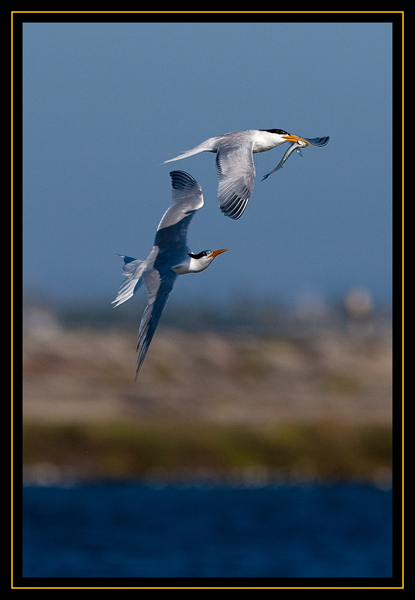On Saturday the 16th I had a get together with some fellow photographers at the Bolsa Chica Wet Lands. I was hoping for some decent activity with the Terns and Black Skimmers. Although the Terns were out in good numbers, there were only a few Skimmers, but none the less they were out and gave me a few opportunities for some shots. There were also a few Pelicans who stayed close by and entertained us with their constant dives in search of food.
Well that brings us to this post. Since the bird activity was pretty good I decided to head back out the following Monday. Now although there were a lot of Terns out, their activity was very minimal. They did make multiple attempts to catch fish, but on the most part came up empty beak (so to speak). There were a few Pelicans, but the decided to come and go during my evening stay and the Skimmer activity was almost nil.
So lets take this post to the next level and talk about how I got the shots I have posted here today. All captions will be talking about the shot above the caption, which is the norm, but I tend to post about the picture below when providing captions.
Although Pelicans are large birds and rather slow flying, when they decide to dive they do so rather quickly and if not paying attention all you will end up with when taking a picture is a big splash. Pelicans tend to dive from various heights and they higher they are the better your chances of following them and getting that diving shot. I have yet to get one, but my goal with them is to get a shot of them in their dive just before making contact with the water - the closer the better. When looking for these shots you need to track the pelican and watch for signs (a slight turn / shoulder drop) as they turn their body and angle downward. The hardest part is tracking them in the dive, but I'm working on that.
Another nice shot is of them taking flight from the water.
With Terns the action is so much faster. You really have to be on top of things to capture them, but as with anything there are some tricks I use. First - the shot am I attempting to capture or looking for - will dictate how I do things.
On the most part I will do my best to be aware of the background and shoot aerial shots when their low enough to give me some color (brush / water) in the background, even if its only through part of the picture. Now I do break this rule (at least I try) when I have nice blue sky's, in this case I will shoot various flybys or hovering shots while they search for fish. For this type of shot being high, such as standing or being further above the water works best as it puts you closer to the birds level and hopefully raises the level of the horizon so when the bird flows low you got a sweet background full of color.
Another shot I look for is their dive, or when they begin their flight out of the water after a dive. For this shot I want to be as low as possible to show more separation between the tern and the water, although this can't always be done depending on where you do your birding, but if you can get low then get low. Once a tern makes a dive it will begin its quick upward jump out of the water. This is where I'm looking for a fish in its beak to add to the shot. The other thing I'm looking for is the head shake. Once they come up out of the water they will shake their head like a dog coming out of a pool. Makes a great shot with water droplets flying outward.
I hope you obtained some information that will help you get that shot you want. Feel free to contact me if you have any questions. I will try to help as best I can.
















No comments:
Post a Comment